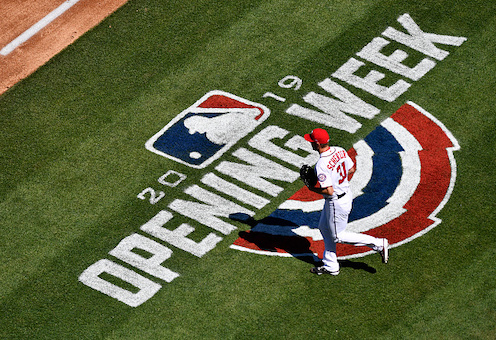With the flutter of the year's first robin redbreast, with the promise of the first warm breeze of spring—the patter of an early April rain, the almost phosphorescent green of young grass, a scent of new life in the morning air—the season turns at last from winter to provide us what we are always given, this time of year: the cloying metaphors of baseball columns. The sentimental globules of Opening Day reflections. The sickly sweet reviews of new baseball books, like the genteel retching of a consumptive maiden.
And so, as the 2019 baseball season gets underway, we have the first snap of pitches into the catcher's mitt. The first spikes scraping at the chalked lines of the batter's box. The first cracks of bats slicing grounders through the infield. And, of course, to go with them, the first ink-and-paste-and-wood-pulp scent of new baseball books. The first of the inevitable efforts of modern baseball prose, desperately seeking a way to meld some good old-fashioned boys-of-summer nostalgic elegance with the deadly statistics of number-crunched sabermetrics. And the first attempts to build large metaphors for all the world: social, psychological, metaphysical—out of the spectacle of grown men at work on a field of grass.
As always, some of the new books on offer this year are for specialized taste. If you're a Dodgers' fan, there's always something for you. The Red Sox, the Angels, the Marlins: Someone somewhere has written something about them for their devotees.
Most of this is even more ephemeral than the usual seasons of the usual teams in baseball. Even more fleeting than the usual run of a new spring's crop of baseball books. Tom Haudricourt's Special Brew: An Inside Look at the 2018 Milwaukee Brewers is of this ilk, although better done than most. The Brewers had a shockingly successful season last year, finishing atop the Central Division of the National League with a 96–67 record before losing 4–3 to the Dodgers in the league championship series. If they had only done a little better—taken one more game and slipped into the World Series—the interview-driven book by the Milwaukee reporter Haudricourt would seem an even more compelling tale of how a failing team gets rebuilt in contemporary baseball.
Meanwhile, for Damn Yankees fans, the New York Times's Bill Pennington has produced Chumps to Champs: How the Worst Teams in Yankees History Led to the '90s Dynasty. It's a tale of the years 1989 to 1992, when the Yankees' record stank like Saturday's fish—while the team had an owner banned from baseball by his own league, hadn't been to the World Series in over a decade, and had to watch the Mets outdraw them in attendance. Somehow, out of that mess, the Yankees managers and general manager managed to build a team that would dominate in subsequent years.
Better still—close to being a universal baseball book—is the offering for longtime Cubs fans: Doug Wilson's Let's Play Two: The Life and Times of Ernie Banks. There is a case to be made that during the late 1950s, Ernie Banks was the most valuable player ever to play. It’s complicated and not really persuasive, but think of it this way: If you were choosing an all-time team and failed to get Babe Ruth at his peak for your right-fielder, you could always take Ted Williams instead. But who could replace Ernie Banks at shortstop—hitting 47 homeruns and leading the league in slugging and total bases in 1958? Well, Honus Wagner, of course, and maybe Alex Rodriguez, if you can stomach him, but there’s little doubt that at his best Ernie Banks was among the best. And Wilson tells well the story of the permanent Cubs favorite.
Architecture critics can't leave the topic of baseball alone. This year's entry, Paul Goldberger's new Ballpark: Baseball in the American City, is less nutty than, say, Jerald Podair's 2017 City of Dreams: Dodger Stadium and the Birth of Modern Los Angeles, but the sensible book about the role of baseball parks in urban planning is also a lot less enjoyable.
On a grander scale, for Opening Day, Berkeley professor Alva Noë has delivered Infinite Baseball: Notes from a Philosopher at the Ballpark. It's a collection of essays about umpires' judgment in baseball, the use of statistics, the problem with drugs, the awkwardness of instant replay, and the physics of the knuckleball. If none of the chapters quite reach the philosophical sophistication of Roland Garrett's 1976 essay, "The Metaphysics of Baseball," the book is still a pleasant and thoughtful read.
As is Tyler Kepner's K: A History of Baseball in Ten Pitches. And, to a lesser degree, Joe Cox's attempt to find something new to say about Jackie Robinson in Fine Team Man. And Roberta J. Newman's surprisingly interesting Here's the Pitch: The Amazing, True, New, and Improved Story of Baseball and Advertising. And . . . and . . .
On and on they go. You cannot watch every baseball game; there are just too many teams playing too many series against one another. And for the same reason, you can't read every bit of baseball writing; there are simply too many words chasing too many topics to run your eyes over all of it.
Still, with the flutter of the year's first robin redbreast, with the first warm breeze of spring, there's something in the spring air that promises a new start. A new season. A new chance to follow the sport through the summer. All the players are equal. All the teams start out with no losses. All things seem possible. Even that this year will be the year you stumble upon a truly great new baseball book.
